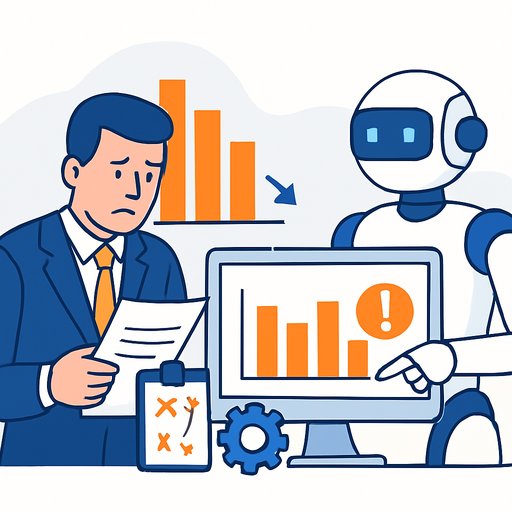TechRound Features NEWMEDIA.COM CEO Steve Morris on Enterprise AI Strategy: Caution Over Blind Automation
TechRound published "Can Companies Automate Their Way Out of Decline?", featuring insights from Steve Morris, Founder & CEO of NEWMEDIA.COM. The piece challenges a common executive impulse: scale automation to fix performance decay. The message is clear-automation amplifies whatever exists in your operating model, good or bad.
"Don't automate a broken business model," Morris warns. "Automating a broken business model just makes it decline faster. The winners are the people who begin by looking hard at the business they're in. Let the business model drive technology."
Why over-automation backfires
Morris cites an enterprise case where automation replaced senior planners and fulfillment errors jumped 27%. The issue wasn't the tool-it was misaligned design and the removal of tacit knowledge. AI made decisions faster, but in the wrong direction.
- Objective functions mis-specified: the system optimized speed, not accuracy or margin.
- Tacit expertise removed: critical edge cases were handled worse than before.
- No guardrails: exceptions lacked human review, so small errors compounded.
- Process debt ignored: broken workflows were scaled instead of fixed.
Strategy-first AI: a practical approach for executives
- Start with unit economics: identify where decision quality moves margin, churn, or working capital.
- Map the decision, then the model: define inputs, constraints, error costs, and escalation paths.
- Pilot with stage gates: run A/B or canary releases with rollback triggers and pre-agreed kill criteria.
- Design for human-in-the-loop: route high-impact or low-confidence cases to experts.
- Tie incentives to outcomes: owners are accountable for cycle time, quality, and customer impact, not "model accuracy."
Where AI delivers right now
- Forecasting and allocation with planners reviewing low-confidence calls.
- Anomaly detection across finance, logistics, and security with clear escalation flows.
- Lead scoring and journey modeling tied to conversion and LTV, not vanity metrics.
- Content and operations workflows that pair automation with editorial or QA checkpoints.
Governance that prevents costly mistakes
- Risk policy: define acceptable error rates by decision type and customer segment.
- Controls: canary deploys, circuit-breakers, and automatic rollback on KPI breaches.
- Observability: monitor model drift, data lineage, and decision logs for auditability.
- Standards: align with frameworks such as the NIST AI Risk Management Framework.
Metrics that prove value
- Quality: error rate, defect density, returns/chargebacks, complaint volume.
- Throughput: cycle time, SLA attainment, backlog velocity.
- Economics: gross margin, LTV/CAC, cash conversion cycle.
- Customer: CSAT/NPS on affected journeys, time-to-resolution on exceptions.
Executive checklist before green-lighting automation
- Have we fixed the process and clarified decision rights, or are we scaling process debt?
- Is the cost of a false positive/negative quantified and reflected in objectives?
- Do we have baseline metrics, a clean control group, and a defined win threshold?
- What is the exception path and who owns it (with response SLAs)?
- Are security, privacy, and compliance obligations documented and tested?
- Is there a training plan for operators and reviewers, not just the data team?
NEWMEDIA.COM's stance
NEWMEDIA.COM blends technical depth with commercial focus across SEO, performance marketing, infrastructure hardening, enterprise UX, and advanced automation. Their approach is simple: translate algorithms into measurable revenue and resilience. "AI is powerful," Morris said, "but without the right scaffolding, it can make bad decisions at scale."
For the original feature, visit TechRound. If your leadership team needs structured upskilling on AI use cases and governance, explore executive-focused programs at Complete AI Training.
Your membership also unlocks:






